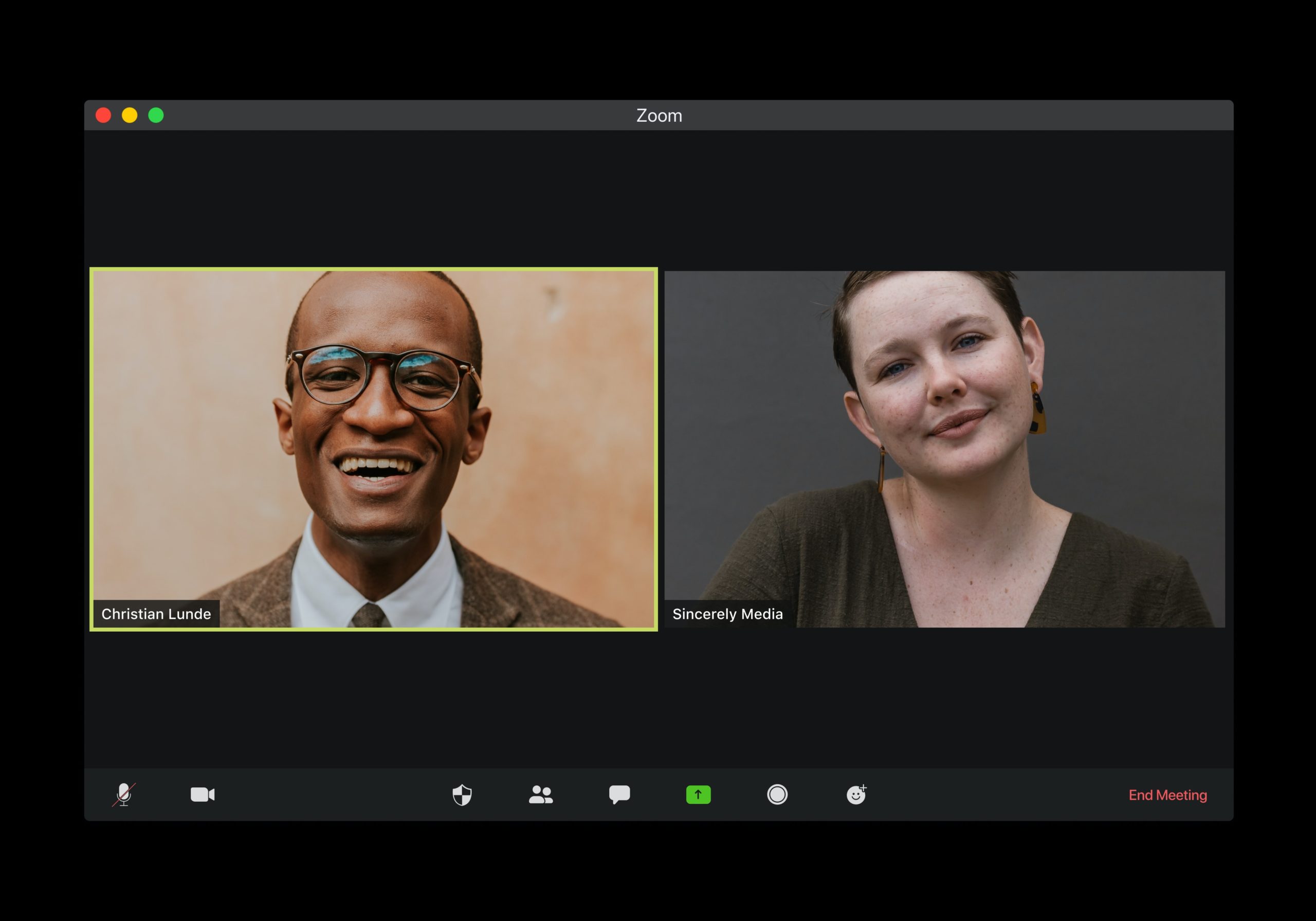
How to record good interviews using video conferencing software
By Thom Choice
Video Interview Tips
In just a year, the way people are securing jobs has drastically changed due to this century’s first serious pandemic. The face-to-face interview has swiftly been replaced with an online counterpart that not only gets results, but leaves room for the interviewer to review post-discussion.
Luckily with the nature of being remote, some of the biggest job interview challenges for both interviewer and interviewee are eased. For hiring managers the process is heavily shortened and streamlined. For prospective candidates, performance anxiety is slightly relieved and they have more tools to show their work through. However, utilising technology to work in your favour is a beast of its own. One that we are going to tackle right now.
From software to hardware, we’re going to give you an all inclusive overview to success in recording high quality footage for your video interviews.
Here are our top video interview tips:
Equipment is Key
Equipment and preparation are incredibly important to video interviews, it goes without saying that the better the connection and audio-visual quality, the greater the perceived calibre of both interviewer and candidate as a high quality experience will leave a consistently positive impression, or at the very least, a lack of a negative one.
However this doesn’t necessarily mean you have to break the bank doing it.
Internet Connection
Having a good internet connection certainly will help your video interview run smoothly. We recommend doing a few tests to see whether your Wifi or 4G connection is stronger and chatting to any housemates or family members about not streaming whilst you’re on your video job interview.
However, we recognise that you can’t always improve your internet connection, so we share some tips on other equipment candidates and interviewers can use to optimise their video interview experience.
Cameras
When it comes to cameras you’re going to want to leave that security hazard of a bad-angled laptop webcam taped up where it is. Most modern laptops, even high-end Macbooks and Microsoft Surface pro’s only support web-cams up to 720p HD.
Now 720p doesn’t sound too bad, however when you find that you can get a 1080p wide angle HD webcam for as low as £10 the effort to properly simulate a face-to-face interview environment becomes far less strenuous.
Another option is probably in your hand or sitting on your desk next to you right now. Modern mobile phones boast impressive megapixel counts and up to 60 frames per second, making them ideal for simulating an in person interview environment. What’s more, some phones offer industry standard camera quality for video recording up to 4k, making your mobile device a better camera than any webcam or built-in computer webcam.
However, your mobile will definitely require a stand to get the camera at eye level, which will be important for maintaining good eye contact and positive body language. Investing in a good phone stand will mean that your will be able to sit directly in front of the camera with a good posture, helping you look professional and personable. Some phone stands come with ring lights to really brighten up your image for a professional quality video feed.
The higher the quality of the video, the better online video attendees will be able maintain a potent social presence, allowing the other viewer to read non verbal cues and maintain eye contact. These factors are a complete necessity as it’s been proven that video interviews suffer in these specific areas, in comparison to face-to-face interview.
Audio
Environment is the first step to good audio, with the flexibility provided by technology, it makes it tempting to take the digital nomads approach and prop up that meeting whilst working from anywhere you please. Background noise makes a huge impact on audio quality, whether it be a fridge buzzing, or a barista grinding the morning brew. Find a quiet place for your interview, speak clearly and try to keep the ambient noise as low as possible.
Much like the choice of camera, you’re going to want to avoid whatever is built into your laptop. Usually the microphones are located in strange places and pick up a lot of ambient noise such as keys tapping or shifting from inside the laptop itself.
There are a range of options to choose from when choosing an external microphone. Generally most options for clear audio are easy to source, and should work whether they are on headphones, built into earbud wires, clip on lapel, or standing desk microphones. However, try to avoid inputs that aren’t situated close to your mouth. You want to have the mic piece as close as possible to the audio source, the further away it is the more distorted the sound will become.
Prepare

Before your live video job interview, we always think it’s a good idea to prepare and practice. No-one wants technical difficulties on the day of their video interview, so we suggest doing a trial run before your your in-person interview to make sure that all your technology is working.
Record yourself answering some interview questions and watch it back to check that your body language is open, you’re speaking loudly, your background is plain or tidy, and the lighting looks good. You’ll want to make a good impression with your prospective employers so we encourage you to keep your camera at eye level so your interviewer is able to see you clearly, use a microphone so they can hear your answers and look directly at the camera to maintain good eye contact with the interviewer.

Software and recording options
Okay, so we have all the equipment set up and ready. But now the issue is, which software is going to work best for hosting the interview and recording these meetings? It’s key that you find a software that helps your video interview process feel as natural as possible.
There are a couple of options that each have their own utility and work together wonderfully for video interviews. I’m going to list some of the best and how they operate independently and together.
OBS studio
OBS studio is the holy grail of video screen recording. An open source recording platform where its utility lies in its diverse range of plugins. The possibilities are endless with users creating add-ons for those in need of all kinds of screen recording options from streaming to interviews. One of its most useful plugins is an option to connect your phone as a camera, either through bluetooth or usb via an app.
For phone camera users utilising OBS studio, you aren’t limited to just recording through the platform itself. Their virtual cam plugin allows you to use that created camera on multiple different video streaming apps like Zoom.
It’s an incredible piece of software, you can find it here, as well as the Virtual cam plugin to connect your phone.
Depending how techy you want to get, OBS has you covered. One of its largest benefits is the ability to completely adjust the recording quality, frame rate and sound. That’s something that most built in recording systems for video conferencing software don’t offer at all. We think this is a great solution for hosting video interviews.
ScreenRec
A versatile app that’s extremely easy to use, useful for meetings where the interviewer requires recorded high quality video from the interviewee. It’s simple, fast, and each recording is given its own private url where the video can be accessed and shared. For a fraction of the complexity of alternatives it boasts an impressive recording quality of 120 frames per second.
This lightweight alternative to OBS can be found here.
Zoom
Zoom has been the rising star of video conferencing during the pandemic. Its mass popularity caused the application to grow above and beyond expectations and now it has become the pillar carrying so many industries’ communication networks throughout lockdown. Due to this, the app’s forced growth has created a wonderfully simple platform to use. Inclusive video recording at up to 1080p onto either your computer or a cloud server with the click of a button. There’s no need for external screen recorders like OBS, however you can still use it with their virtual camera to utilise that crystal clear phone quality!
While it doesn’t have quite the utility that OBS offers, Zoom is as simplistic as it gets with no fuss or worry. Before joining a call, it’s easy to test your audio and camera and make sure that your external microphone is working. Offering a free and paid-for service, Zoom has everything you need to streamline your hiring process.
Skype
Skype has made a surprising comeback when having to tackle the rise of Zoom, their business meet options allow 1080p recording and the app itself has been streamlined to work far better than its predecessor. Skype boasts cheaper business plans as well as contains functionality with Microsoft Sharepoint making it a strong contender.
GoogleMeet
GoogleMeet is an easy, all in one platform and the cheapest business option. Recordings are sent straight into the organiser’s google drive folder making it possibly the easiest out of the three options due to the flexibility of google drive. However that being said, like Zoom, there are limited video quality options. The max resolution for google meet is 720p which is the worst of the five platforms.
What makes a platform like GoogleMeet great for video interviews, is that you have the option to blur out your background, which is great if you work in a cluttered office or back bedroom!
Finding the Right Person

Finding the right person to join your company can be challenging, especially when video interview has become the pre-requisite to any hiring process. Video interview is also a novel experience for the interviewee and can make the job search feel perplexing and impersonal.
Using good equipment is key to helping your video interview go as well as it possibly could, helping communicate your positive body language, let your conversation come across natural, and sustain eye contact with your interviewer or interviewee.
Video Interview Recording – Conclusion
For quality interview recording in 2021, OBS studio is a must have. It’s an extremely versatile software for hiring managers that not only makes for a professional recording setup to host interviews. But offers so many options for utility such as overlays, screen sharing, picture sharing and multiple video sources.
However, if that’s too much to chew. ScreenRec offers an easy and effective solution to any recording needs on any platform, for absolutely free. Making it a useful tool to assist interviewers in gaining quality recording from candidates.
Combining one of these two platforms with a video conferencing software of choice is a powerful combo that creates the perfect setup for recording high calibre video recordings to be reviewed at any time.
Written by Thom Choice
Reference Links
- https://www.digitaltrends.com/computing/laptops-need-better-webcams/
- https://www.amazon.co.uk/TIJA-Microphone-Microsoft-Compatible-Conferencing/dp/B08P39TTLS/ref=sr_1_6?_encoding=UTF8&c=ts&dchild=1&keywords=Webcams+%26+VoIP+Equipment&qid=1622115370&s=computers&sr=1-6&ts_id=429893031
- https://link.springer.com/article/10.1007/s10869-020-09714-3
- https://www.youtube.com/watch?v=DJqwrOx1siM
- https://www.amazon.co.uk/LEYMING-Microphone-Omnidirectional-Compatible-Conferencing-Black/dp/B08LVK2D83/ref=sr_1_2_sspa?dchild=1&keywords=external+microphone&qid=1622118297&refinements=p_72%3A419153031%2Cp_36%3A-2500&rnid=389035011&s=electronics&sr=1-2-spons&psc=1&spLa=ZW5jcnlwdGVkUXVhbGlmaWVyPUEzRUpQMFEwQkZFQlgmZW5jcnlwdGVkSWQ9QTA1NTQyODgyNjFVNjBBRklBNThOJmVuY3J5cHRlZEFkSWQ9QTAyNDI5NTgzUkxEOE44R01FWVBRJndpZGdldE5hbWU9c3BfYXRmJmFjdGlvbj1jbGlja1JlZGlyZWN0JmRvTm90TG9nQ2xpY2s9dHJ1ZQ==
- https://obsproject.com/download
- https://obsproject.com/forum/resources/obs-virtualcam.949/
- https://screenrec.com/screen-recorder/how-to-record-your-computer-screen-windows-10/
